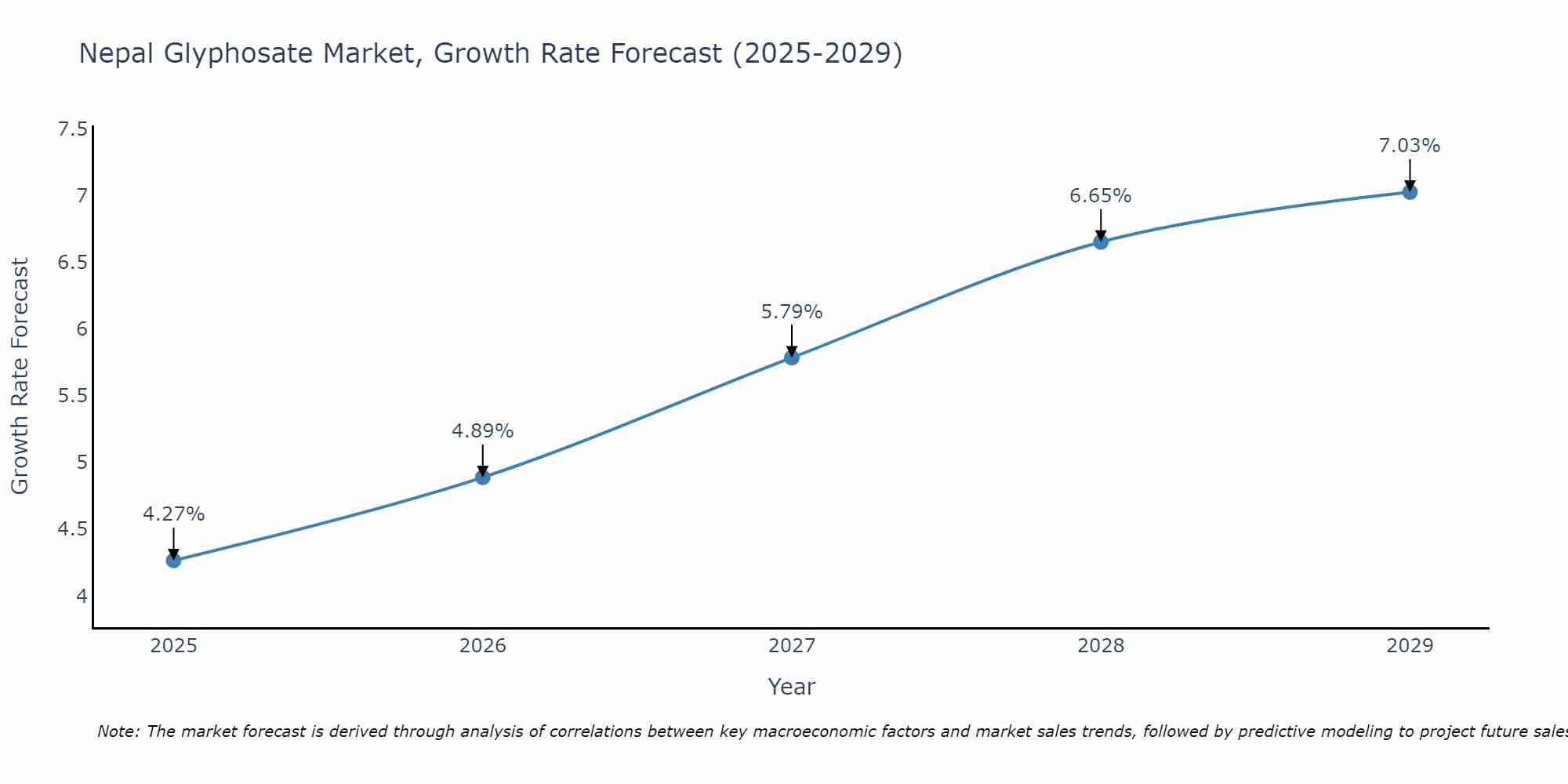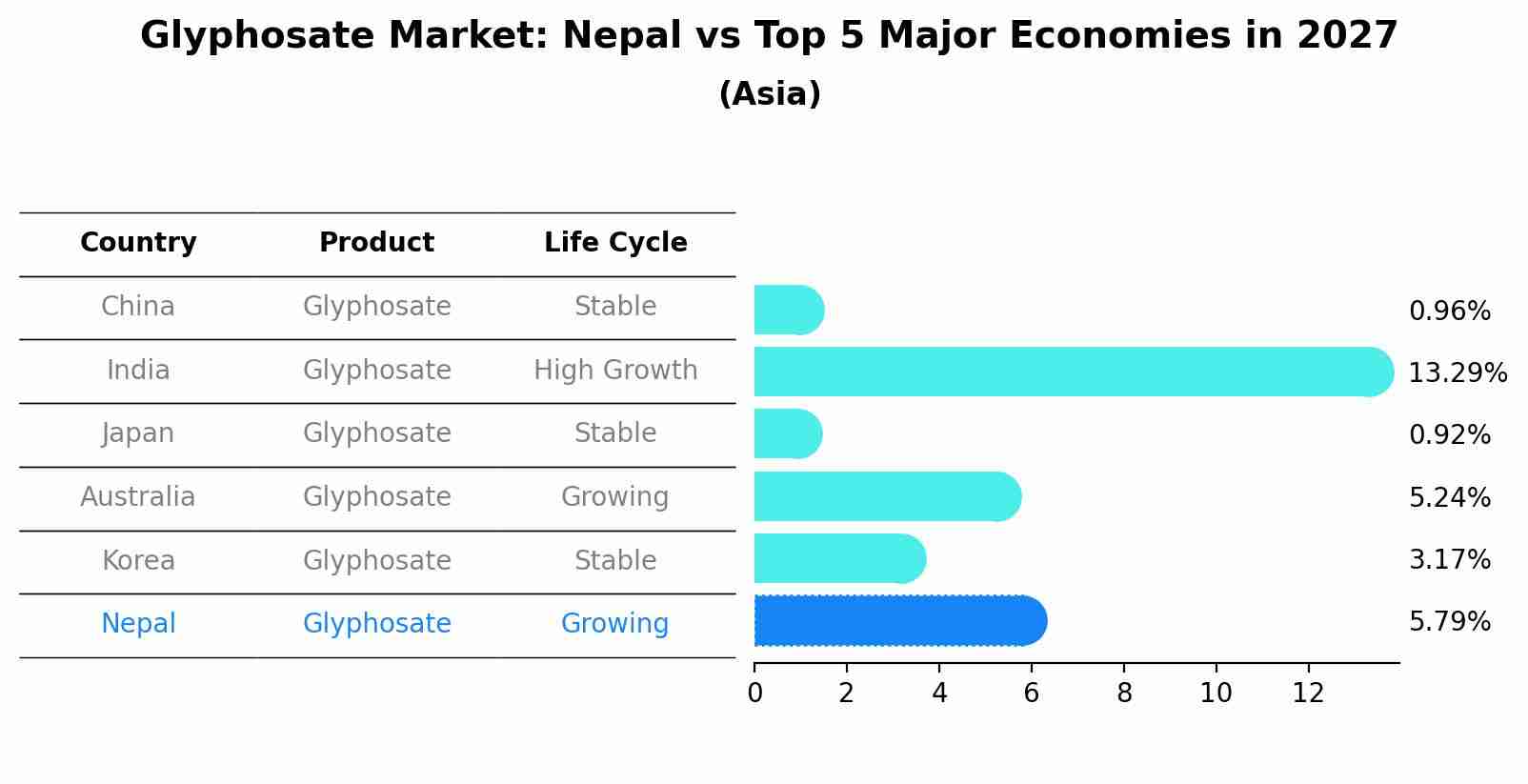Nepal Glyphosate Market (2025-2031) Outlook | Trends, Share, Industry, Analysis, Value, Growth, Forecast, Size, Companies & Revenue
| Product Code: ETC415772 | Publication Date: Oct 2022 | Updated Date: Aug 2025 | Product Type: Market Research Report | |
| Publisher: 6Wresearch | Author: Ravi Bhandari | No. of Pages: 75 | No. of Figures: 35 | No. of Tables: 20 |
Nepal Glyphosate Market Size Growth Rate
The Nepal Glyphosate Market is likely to experience consistent growth rate gains over the period 2025 to 2029. The growth rate starts at 4.27% in 2025 and reaches 7.03% by 2029.

Glyphosate Market: Nepal vs Top 5 Major Economies in 2027 (Asia)
Nepal's Glyphosate market is anticipated to experience a growing growth rate of 5.79% by 2027, reflecting trends observed in the largest economy China, followed by India, Japan, Australia and South Korea.

Nepal Glyphosate Market Synopsis
The Nepal Glyphosate market is primarily driven by the increasing demand for herbicides in the agriculture sector to control weeds effectively and enhance crop yield. Glyphosate, a widely used herbicide in Nepal, is favored for its broad-spectrum weed control capabilities and cost-effectiveness. The market is witnessing growth due to the rising adoption of modern farming practices and the need for sustainable agricultural solutions. Key players in the Nepal Glyphosate market are focusing on product innovation, strategic partnerships, and marketing initiatives to expand their market presence. Government regulations and environmental concerns are also influencing market dynamics, leading to a shift towards more environmentally friendly herbicide alternatives. Overall, the Nepal Glyphosate market shows promising growth prospects in the coming years driven by the agriculture sector`s evolving needs and technological advancements.
Nepal Glyphosate Market Trends
The Nepal Glyphosate Market is experiencing a shift towards sustainable and organic farming practices, leading to a growing demand for alternative weed control solutions. This trend is driven by increasing awareness about the harmful effects of chemical herbicides on human health and the environment. Farmers are increasingly turning to natural and eco-friendly alternatives such as bio-herbicides and integrated weed management techniques. Additionally, the government`s stricter regulations on glyphosate usage and promotion of organic farming are influencing market dynamics. As a result, there is a rising interest in bio-based and non-toxic weed control products in Nepal, indicating a gradual transition away from conventional glyphosate-based herbicides in the agricultural sector.
Nepal Glyphosate Market Challenges
In the Nepal Glyphosate Market, several challenges are faced, including regulatory restrictions and bans on the use of glyphosate in agriculture due to concerns over its potential health and environmental impacts. This has led to uncertainty among farmers and agrochemical companies regarding the future availability and legality of glyphosate-based products. Additionally, the presence of counterfeit or substandard glyphosate products in the market poses a threat to crop yields and farmer incomes. Lack of awareness and proper training on the safe usage of glyphosate further exacerbates the issue of misuse and environmental contamination. These challenges highlight the need for stringent regulations, effective enforcement mechanisms, and educational campaigns to ensure the responsible and sustainable use of glyphosate in Nepal.
Nepal Glyphosate Market Investment Opportunities
In the Nepal Glyphosate market, there are several investment opportunities worth considering. With agriculture being a significant sector in Nepal, the demand for glyphosate, a widely used herbicide, is expected to remain strong. Investing in companies involved in the production, distribution, or sale of glyphosate products could be lucrative. Additionally, there is potential for investment in research and development of more sustainable and environmentally friendly alternatives to glyphosate, as there is a growing trend towards organic farming practices in Nepal. Furthermore, investing in technologies that enhance the efficiency and effectiveness of glyphosate application could also present opportunities for growth in the market. Overall, the Nepal Glyphosate market offers diverse investment avenues for those looking to capitalize on the country`s agricultural industry.
Jordan Agar Market Government Policies
The Nepal government has implemented strict regulations regarding the use of glyphosate, a widely used herbicide. In 2019, the government imposed a complete ban on the import, sale, and use of glyphosate within the country, citing environmental and health concerns. This ban was reinforced by the Ministry of Agriculture and Livestock Development in 2020, emphasizing the need to protect human health and the environment from the harmful effects of glyphosate. As a result, the Nepal Glyphosate Market has been greatly impacted, with farmers and agricultural businesses having to seek alternative solutions for weed control. The government`s stance on glyphosate reflects a growing global trend towards more stringent regulations on potentially harmful agrochemicals, encouraging the adoption of sustainable and eco-friendly agricultural practices in the country.
Nepal Glyphosate Market Future Outlook
The future outlook for the Nepal Glyphosate Market is expected to be positive, driven by factors such as increasing adoption of modern agricultural practices, rising demand for high-quality crops, and the need for effective weed control solutions. Glyphosate, a widely used herbicide in Nepal, is likely to continue to be in high demand among farmers looking to improve their crop yields and reduce labor costs. However, the market may face challenges related to regulatory restrictions and growing concerns about environmental and health impacts associated with glyphosate use. Overall, the market is projected to witness moderate growth in the coming years, with opportunities for innovation and sustainable practices to shape the industry`s future trajectory.
Key Highlights of the Report:
- Nepal Glyphosate Market Outlook
- Market Size of Nepal Glyphosate Market, 2024
- Forecast of Nepal Glyphosate Market, 2031
- Historical Data and Forecast of Nepal Glyphosate Revenues & Volume for the Period 2021 - 2031
- Nepal Glyphosate Market Trend Evolution
- Nepal Glyphosate Market Drivers and Challenges
- Nepal Glyphosate Price Trends
- Nepal Glyphosate Porter's Five Forces
- Nepal Glyphosate Industry Life Cycle
- Historical Data and Forecast of Nepal Glyphosate Market Revenues & Volume By Application for the Period 2021 - 2031
- Historical Data and Forecast of Nepal Glyphosate Market Revenues & Volume By Genetically Modified (GM) Crops for the Period 2021 - 2031
- Historical Data and Forecast of Nepal Glyphosate Market Revenues & Volume By Conventional Crops for the Period 2021 - 2031
- Nepal Glyphosate Import Export Trade Statistics
- Market Opportunity Assessment By Application
- Nepal Glyphosate Top Companies Market Share
- Nepal Glyphosate Competitive Benchmarking By Technical and Operational Parameters
- Nepal Glyphosate Company Profiles
- Nepal Glyphosate Key Strategic Recommendations
Frequently Asked Questions About the Market Study (FAQs):
1 Executive Summary |
2 Introduction |
2.1 Key Highlights of the Report |
2.2 Report Description |
2.3 Market Scope & Segmentation |
2.4 Research Methodology |
2.5 Assumptions |
3 Nepal Glyphosate Market Overview |
3.1 Nepal Country Macro Economic Indicators |
3.2 Nepal Glyphosate Market Revenues & Volume, 2021 & 2031F |
3.3 Nepal Glyphosate Market - Industry Life Cycle |
3.4 Nepal Glyphosate Market - Porter's Five Forces |
3.5 Nepal Glyphosate Market Revenues & Volume Share, By Application, 2021 & 2031F |
4 Nepal Glyphosate Market Dynamics |
4.1 Impact Analysis |
4.2 Market Drivers |
4.2.1 Increasing adoption of modern farming practices in Nepal |
4.2.2 Rising demand for high-yield agricultural products |
4.2.3 Government initiatives to boost agricultural productivity |
4.3 Market Restraints |
4.3.1 Concerns over environmental impact and health hazards associated with glyphosate |
4.3.2 Growing popularity of organic farming methods |
4.3.3 Competition from alternative weed control solutions |
5 Nepal Glyphosate Market Trends |
6 Nepal Glyphosate Market, By Types |
6.1 Nepal Glyphosate Market, By Application |
6.1.1 Overview and Analysis |
6.1.2 Nepal Glyphosate Market Revenues & Volume, By Application, 2021 - 2031F |
6.1.3 Nepal Glyphosate Market Revenues & Volume, By Genetically Modified (GM) Crops, 2021 - 2031F |
6.1.4 Nepal Glyphosate Market Revenues & Volume, By Conventional Crops, 2021 - 2031F |
7 Nepal Glyphosate Market Import-Export Trade Statistics |
7.1 Nepal Glyphosate Market Export to Major Countries |
7.2 Nepal Glyphosate Market Imports from Major Countries |
8 Nepal Glyphosate Market Key Performance Indicators |
8.1 Adoption rate of modern farming practices in Nepal |
8.2 Growth in agricultural productivity in Nepal |
8.3 Usage of glyphosate per hectare of agricultural land |
9 Nepal Glyphosate Market - Opportunity Assessment |
9.1 Nepal Glyphosate Market Opportunity Assessment, By Application, 2021 & 2031F |
10 Nepal Glyphosate Market - Competitive Landscape |
10.1 Nepal Glyphosate Market Revenue Share, By Companies, 2024 |
10.2 Nepal Glyphosate Market Competitive Benchmarking, By Operating and Technical Parameters |
11 Company Profiles |
12 Recommendations |
13 Disclaimer |
- Single User License$ 1,995
- Department License$ 2,400
- Site License$ 3,120
- Global License$ 3,795
Search
Thought Leadership and Analyst Meet
Our Clients
Related Reports
- Canada Oil and Gas Market (2026-2032) | Share, Segmentation, Value, Industry, Trends, Forecast, Analysis, Size & Revenue, Growth, Competitive Landscape, Outlook, Companies
- Germany Breakfast Food Market (2026-2032) | Industry, Share, Growth, Size, Companies, Value, Analysis, Revenue, Trends, Forecast & Outlook
- Australia Briquette Market (2025-2031) | Growth, Size, Revenue, Forecast, Analysis, Trends, Value, Share, Industry & Companies
- Vietnam System Integrator Market (2025-2031) | Size, Companies, Analysis, Industry, Value, Forecast, Growth, Trends, Revenue & Share
- ASEAN and Thailand Brain Health Supplements Market (2025-2031) | Strategy, Consumer Insights, Analysis, Investment Trends, Opportunities, Growth, Size, Share, Industry, Revenue, Segments, Value, Segmentation, Supply, Forecast, Restraints, Outlook, Competition, Drivers, Trends, Demand, Pricing Analysis, Competitive, Strategic Insights, Companies, Challenges
- ASEAN Bearings Market (2025-2031) | Strategy, Consumer Insights, Analysis, Investment Trends, Opportunities, Growth, Size, Share, Industry, Revenue, Segments, Value, Segmentation, Supply, Forecast, Restraints, Outlook, Competition, Drivers, Trends, Demand, Pricing Analysis, Competitive, Strategic Insights, Companies, Challenges
- Europe Flooring Market (2025-2031) | Outlook, Share, Industry, Trends, Forecast, Companies, Revenue, Size, Analysis, Growth & Value
- Saudi Arabia Manlift Market (2025-2031) | Outlook, Size, Growth, Trends, Companies, Industry, Revenue, Value, Share, Forecast & Analysis
- Uganda Excavator, Crane, and Wheel Loaders Market (2025-2031) | Strategy, Consumer Insights, Analysis, Investment Trends, Opportunities, Growth, Size, Share, Industry, Revenue, Segments, Value, Segmentation, Supply, Forecast, Restraints, Outlook, Competition, Drivers, Trends, Demand, Pricing Analysis, Competitive, Strategic Insights, Companies, Challenges
- Rwanda Excavator, Crane, and Wheel Loaders Market (2025-2031) | Strategy, Consumer Insights, Analysis, Investment Trends, Opportunities, Growth, Size, Share, Industry, Revenue, Segments, Value, Segmentation, Supply, Forecast, Restraints, Outlook, Competition, Drivers, Trends, Demand, Pricing Analysis, Competitive, Strategic Insights, Companies, Challenges
Industry Events and Analyst Meet
Whitepaper
- Middle East & Africa Commercial Security Market Click here to view more.
- Middle East & Africa Fire Safety Systems & Equipment Market Click here to view more.
- GCC Drone Market Click here to view more.
- Middle East Lighting Fixture Market Click here to view more.
- GCC Physical & Perimeter Security Market Click here to view more.
6WResearch In News
- Doha a strategic location for EV manufacturing hub: IPA Qatar
- Demand for luxury TVs surging in the GCC, says Samsung
- Empowering Growth: The Thriving Journey of Bangladesh’s Cable Industry
- Demand for luxury TVs surging in the GCC, says Samsung
- Video call with a traditional healer? Once unthinkable, it’s now common in South Africa
- Intelligent Buildings To Smooth GCC’s Path To Net Zero


















